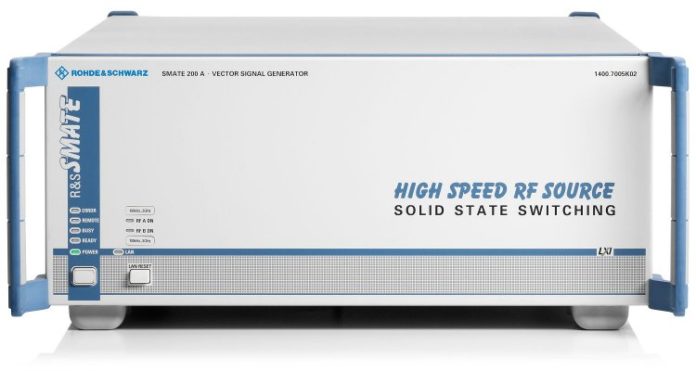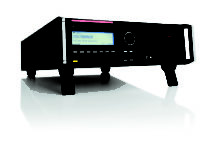Key Facts
- Up to two independent signal generators in one unit
- 3 GHz or 6 GHz frequency options in one or two paths
- Very short setting times for frequency and level (frequency changes < 1 ms over GPIB and < 400 μs in List mode)
- Fast Hop mode offering flexibly addressable frequency/level pairs; as fast as normal List mode
- Multisegment waveform function enabling fast switching between different test signals in waveform generator
- Up to two baseband generators with realtime coder and arbitrary waveform generator
Brief Description
Based on the successful R&S®SMU200A platform, the R&S®SMATE200A is specifically designed for production environments. As such, the display and front panel user interface have been removed, the connectors moved to the rear, and performance has been optimized for fastest setting times to improve factory throughput. Like the R&S®SMU200A, the two-generators-in-one concept has been kept, occupying four height units – a plus for production where space is at a premium. All of this is available without compromising the excellent RF performance and baseband flexibility.
Speaking of flexibility, the modular design concept of the R&S®SMATE200A means that the R&S®SMATE200A can easily be adapted to the needs of any application. Users have the choice of either 3 GHz or 6 GHz RF outputs in one or two paths and may opt for up to two completely independent baseband sources. As in the R&S®SMU200A, these sources may be used to produce complex signals in realtime or output preloaded waveforms from the internal arbitrary waveform generator.
In addition to its inherent speed, the R&S®SMATE200A also offers a special function to permit fast switching between different test signals. The multisegment waveform function allows users to easily combine waveforms, such as GSM and WCDMA, during test setup for even faster tests in production. This is just one of the R&S®SMATE200A’s numerous adaptations to the special requirements of the production environment.
Specifications
| Frequency | |
| Frequency range | 100 kHz to 3 GHz/6 GHz |
| Setting time | <1 ms |
| Setting time in List mode | <400 µs |
| Level | |
| Level range | -144 dBm to +13 dBm (PEP) [+16 dBm in overrange] |
| Level range with High-Power Output option | -144 dBm to +19 dBm (PEP) [+26 dBm in overrange] |
| Setting time | <1 ms |
| Setting time in List mode | <1 ms |
| Spectral purity (f = 1 GHz) | |
| Nonharmonics Carrier offset > 10 kHz Carrier offset > 800 kHz |
<-80 dBc <-86 dBc |
| SSB phase noise (20 kHz carrier offset, 1 Hz meas. bandwidth) |
typ. -135 dBc typ. -140 dBc with option Low Phase Noise |
| Wideband noise (carrier offset >10 MHz, 1 Hz meas. bandwidth) |
typ. -153 dBc (CW) typ. -149 dBc (I/Q modulation) |
| ACLR performance | |
| 3GPP FDD test model 1, 64 | typ. 70 dB |
| I/Q bandwidth (RF) | |
| Internal | 80 MHz |
| External | 200 MHz |
| Arbitrary waveform generator | |
| Memory depth | 16 Msamples/64 Msamples/128 Msamples |
| Interfaces |
| IEEE 488.2, LAN (Gigabit Ethernet), 2x USB, 1x USB slave, VGA |













![[AECO- Fiber Optic Sensors- Cảm biến vị trí sợi quang- Những tính năng ưu việt]](https://www.aoip.com.vn/wp-content/uploads/12-100x70.png)







Comments are closed.